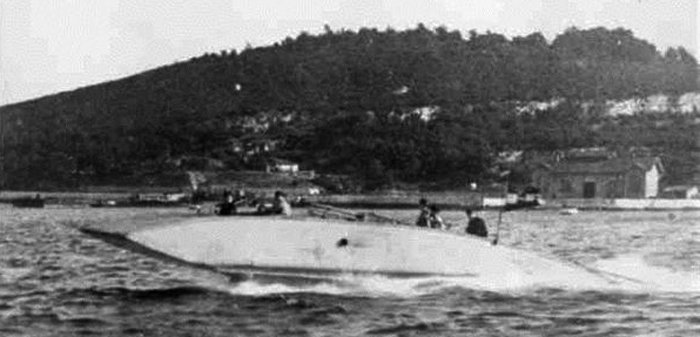
The KuK Versuchsgleitboot or “glider boat” was a mix between a WiG (Wing in Ground Effect) and hovercraft back in 1916.
One of the earliest military examples of such vehicle was the very innovative Austro-Hungarian Versuchsgleitboot, an attempt to devise a “gliding boat”. It was not really a hovercraft since no air was trapped underneath, more of an Ekranoplane. The end goal was to devise blazing fast motor torpedo boats to sink allied battleships and cruisers, and restore balance in the Adriatic. It remained however a prototype, built in 1916 by Dagobert Müller von Thomamuehl. However using the engines of the time it could only reach 32.6 knots top speed. This was way above anything for a military boat.
The Versuchsgleitboot used side skirts which only partially trapped air – it was still capable to flow freely between the two ends of the wing, and the air cushion was located towards the front and capable of lifting the rear section of the boat up to 10 inches off the surface and the whole hull was completely off the water surface as the craft passed 20 knots. But it was unstable, dangerous in high seas, too wobbly to launch torpedoes with precision or use depth charges. After testing the board did not recommended its use and suggested concentrating on torpedo planes instead.
Launched on 1 September 1915 it underwent extensive trials with different propeller types but was considered unworthy of further development due to a number of technical deficiencies. What really was needed was a fast, armoured MTB, so the Versuchsgleitboot was cannibalized and finally scrapped during the following years.
Builder: Seearsenal Pola
Crew: 5
Length: 13m
Beam: 4m
Displacement: 6.5t
2 shafts driven by 4 120PS aero engines
1 air compressor driven by a 65PS aero engine with a flow rate of 450 m3/min
2 450mm Torpedoes
3-6 anti-submarine bombs
1 Schwarzlose machine gun
In fact, pilots were already well aware of this ground effect phenomenon as they could feel it when landing. Some aircraft created such ground effect that they even “refused to land”. The modern-day Hercules transport being a prime example. But this was true because the engines were under-powered and the whole structure very light. One French author Maurice Le Sueur even expressed the idea of using ground interference permanently as a way of locomotion. Over the ground was nearly impossible but over water, that was another story, so early experiments focused on that area. It took time to mature this technology, in fact decades, up to 1960, when on both sides of the Cold War, Rostislav Alexeyev for the Soviet Union and Alexander Lippisch, for United States started work on this concept.
Lippisch Rhein-Flugzeugbau X114, later incorporated in the short-lived Hanno Fischer’s Flugmechanik’s personal craft.
Lippisch is familiar because of the first rocket-propelled jet, the WWII Messerschmitt 163 Komet. But Lippisch, a glider specialist, became known for his work on tailless aircraft and many other aspects of flight. He eventually settled in the USA.
The first proof of the concept by Dr. Lippisch
It was in the sixties, when Dr. Lippisch experimented with Ground Effect configurations. The result was the aerodynamic layout, in which the reversed delta wing was combined with a high positioned T-tail.
Until now, it is the only Ground Effect configuration, which proofed its inherent length and height stability in and out of Ground Effect theoretical and in operation.
Dr. Lippisch first designs were designed as aircraft, for which the ability to safely operate in and out of Ground Effect was truly essential. On the other side, this original ability for free flight was great disadvantage to develop a Ground Effect Craft as a commercial useful product: The basic advantage of a Ground Effect Craft is it’s possible cheap operation.
To burden this advantage with the additional expenses to produce, register and operate a Ground Effect Craft as an aircraft, is completely unfeasible. Beside that, for very feasible reasons, a good Ground Effect Craft is a very bad aircraft, and vice versa.
Rhein-Flugzeugbau GmbH
In the late sixties, RFB with Mr. Hanno Fischer as a technical director started to evaluate Ground Effect Craft by order of the German MoD. With Dr. Lippisch as a consultant, they developed the X-113 as a successor of the X-112 in order to fulfill the task of the design evaluation.
After a successful series of tests with the X-113, a new design was started to cover the Navy requirement to observe the Baltic Sea as per NATO requirement of that time.
Different to the X-113, the X-114 was a Catamaran Design, where the fuselage was above the water, and the sponsons had to give the displacement needed.
Also this craft was successfully operated. To improve sea worthiness during take off and landing, the X-114 was modified to the X-114H with hydrofoils. Due an error of the test pilot that time, the X-114 got lost during trials, while the Pilot survived uninjured.
At the end of the both programs, the conclusion was, that the technical and the military suitability was proven.
However, for civil applications, the registration of both craft as aircraft in those early years, was an extreme disadvantage, which prohibited the attempt to approach the market.
General characteristics
Crew: One
Capacity: Five or six passengers
Length: 12.80 m (42 ft 0 in)
Wingspan: 7.00 m (23 ft 0 in)
Height: 2.90 m (9 ft 6 in)
Empty weight: 1,000 kg (2,205 lb)
Max takeoff weight: 1,500 kg (3,307 lb)
Powerplant: 1 × Lycoming IO-360 flat four, 150 kW (200 hp)
Propellers: 5-bladed ducted pusher configuration
Performance
Cruise speed: 150 km/h (93 mph, 81 kn) in ground effect. Out of ground effect, estimated: 200 km/h (124 mph; 108 kn)
Range: 2,000 km (1,200 mi, 1,100 nmi) approximately, in ground effect
Endurance: 20 hr, in ground effect